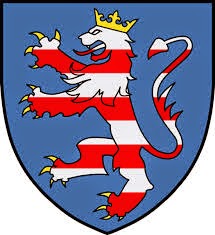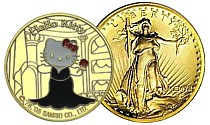 |
| The medal in question: The rambant lion with crown was to much like the Norwegian coat of arms. But is it really a Norwegian lion? Photo from the sales campaign. |
The important thing is: The Norwegian coat of arms has a lion, with crown and axe. The axe makes the lion a symbol of something Norwegian in the world of heraldics (we don't kill our kings on a regular basis, but it happened in 1030).
 |
| Rampant lion with crown, but without axe: Coat of arms of Hessen. |
A few years ago the Norwegian foreign office crashed the party, and declared that only officially sanctioned coinage and medals could have the Norwegian coat of arms struck into them. This was of course sad, but the Norwegian government have the right to do this. Who else owns the copyright of the emblem than the Norwegian state itself, and a nation don't want to officially emboss every medal issue made for the norwegian consumer market.
This fact has then resulted in a lot of different medals, minted at The Norwegian Mint, with different rampant lions. Many of these medals was made for Samlerhuset AS - a company that has sold a lot of medals with big price tags. The last issue was however a medal they give away for free (or you just pay the postage).
The medal was issued to commemorate the merchant sailors during WW2. They are well respected and many of them are decorated for bravery. And they deserve every medal they got. The problem was that this new medal had a image of a rampant lion with crown. But not the Norwegian one - as everybody expects, but a lion from another kingdom. Or company.
 |
| Rampant lion without crown and axe: The trademark of Peugeot. |
And as many of my geeky friends know: A rampant lion with a sword is the coat of arms for Finland. That lion is also crowned.
 |
| Soon to be found on norwegian medals? Rampant lion with crown and sword: Coat of arms of Finland. |
In the end: Would it not be simpler if the Norwegian government by the foreign office just sanctioned the medal? It surely must be better to honor the brave merchant sailors of WW2 with a medal that is impressed with a lion with some connection to the country they served: Norway. It's getting embarrasing. The sailors deserve the best - the original Norwegian lion, not a substitute.
